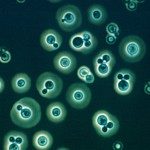Link to Pubmed [PMID] – 19250641
Biochem. Biophys. Res. Commun. 2009 Mar;380(3):525-30
Phosphatidylinositol kinases (PIK) are at the heart of one of the major pathways of intracellular signal transduction. The signals made by PIK influence a wide variety of cellular functions, including cell growth, differentiation and survival, glucose metabolism and cytoskeletal organization. Wortmannin strongly binds in vitro to all PIK subtypes and it is therefore an effective antiproliferative agent. This study is the first report on a survey made by similarity searches against Schistosoma mansoni genome available to date for phosphatidylinositol- and related-kinases (SmPIKs). We classified the SmPIKs according to five models (1-5). SmPIK sequences were retrieved from GeneDB (http://www.genedb.org) by means of a combinatorial approach which uses terms defined in genome annotation associated with PFAM (Protein Families) domains, BLAST analysis and COGs (Clusters of Orthologous Groups of proteins). This approach detects the kinase (catalytic) domain structure and also the recently described FAT and FATC motifs.
